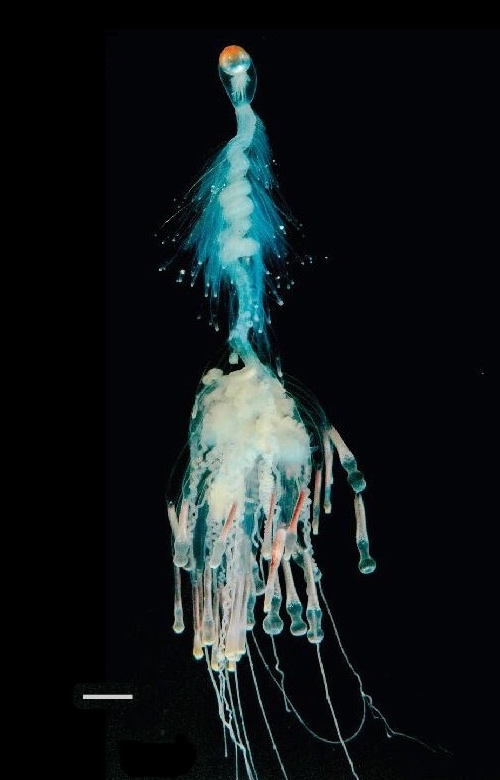Please tell me animal facts!
Squids? Jellyfish? Or what?
Siphonophores.
https://en.wikipedia.org/wiki/Siphonophorae
Kind of... colonies of polyps and jellyfish functioning as whole organisms?
_________________
Let's not confuse being normal with being mentally healthy.
<not moderating PPR stuff concerning East Europe>
dragonsanddemons
Veteran

Joined: 19 Mar 2011
Gender: Non-binary
Posts: 6,659
Location: The Labyrinth of Leviathan
Most insects are not actually bugs. There is a specific family (I think, might have the level of classification wrong) of insects that are called “true bugs.” They are fairly easily identifiable because every one has an upside-down triangle shape on its back. Insects that are true bugs include stinkbugs, cicadas, and boxelder bugs.
_________________
Yet in my new wildness and freedom I almost welcome the bitterness of alienage. For although nepenthe has calmed me, I know always that I am an outsider; a stranger in this century and among those who are still men.
-H. P. Lovecraft, "The Outsider"
Nematode worms are so common that roughly 4 out of 5 individual animals is reckoned to be a nematode. One square meter of soil can contain over a million of them. They're equally common on the sea floor, and have even been found in mines a few kilometers below the ground. Most species are tiny - less than 2.5mm long - and hard to tell apart.
Humans: "It is the Age of Mammals!"
Insects: "Ahem."
Nematodes: "AHEM."
_________________
You're so vain
I bet you think this sig is about you
You should Google insect eating sloth bears, they are incredibly cute!
Playing with a jumping spider sounds fun.
_________________
"The inherent worth and dignity of every human person"
"I'm not good, I'm not nice, I'm just right!"
"Congratulations to the dry eyes, and consolations to the nice guys"
Humans: "It is the Age of Mammals!"
Insects: "Ahem."
Nematodes: "AHEM."
Nematodes (aka "round worms")
And they live in animals as parasites too. A book I read quoted a scientist saying that "If you removed everything on the earth's surface except nematodes, and just left the nematodes where they are....suspended in mid air- the landscape would still be recognizable. It would be ghost world the soil and hills would still look the same because of the huge number of nematodes still be there. AND you would still see your pets running around on top of the land. The nematode parasites of birds and animals (and even humans) would be suspended in air. And if you were a specialist you could even recognized the species of animal." This bunch of nematodes specializes in dogs...so that's my dog, and that's my cat, and that's a mockingbird flying over head....
Squids? Jellyfish? Or what?
Siphonophores.
https://en.wikipedia.org/wiki/Siphonophorae
Kind of... colonies of polyps and jellyfish functioning as whole organisms?
Siphonophores were what got me interested in the wilder fringes of zoology. About 10 years ago, I stumbled across the Wikipedia article on the "Portuguese Man o' War" and suddenly the world became a much stranger place.
_________________
You're so vain
I bet you think this sig is about you
dragonsanddemons
Veteran

Joined: 19 Mar 2011
Gender: Non-binary
Posts: 6,659
Location: The Labyrinth of Leviathan
If I remember correctly, parasites are the only organisms to undergo reverse-evolution, for example “evolving” to lose most of the digestive system because the host’s body does the digestion for them.
_________________
Yet in my new wildness and freedom I almost welcome the bitterness of alienage. For although nepenthe has calmed me, I know always that I am an outsider; a stranger in this century and among those who are still men.
-H. P. Lovecraft, "The Outsider"
Owls lack a sense of smell, and are therefore capable of preying on skunks.
Actually, that's still evolution going "forward"; adapatation to an environment over time is still adaptation over time, even if it takes the form of losing organs that are no longer useful. For comparison, consider that the ancestors of whales had legs, but lost them over time because they became increasingly aquatic.
_________________
I'm bored out of my skull, let's play a different game. Let's pay a visit down below and cast the world in flame.
dragonsanddemons
Veteran

Joined: 19 Mar 2011
Gender: Non-binary
Posts: 6,659
Location: The Labyrinth of Leviathan
Actually, that's still evolution going "forward"; adapatation to an environment over time is still adaptation over time, even if it takes the form of losing organs that are no longer useful. For comparison, consider that the ancestors of whales had legs, but lost them over time because they became increasingly aquatic.
I thought I remembered the term “reverse evolution” being used for it in one of my classes. Perhaps I was mistaken. Or perhaps the teacher wasn’t using the term properly.
Well, in any case, only one breed of rabbit (called the swamp rabbit, if I remember correctly) can swim.
_________________
Yet in my new wildness and freedom I almost welcome the bitterness of alienage. For although nepenthe has calmed me, I know always that I am an outsider; a stranger in this century and among those who are still men.
-H. P. Lovecraft, "The Outsider"
There are thousands of kind of wasps, some of them are actuallly quite useful...there are even specific fig wasps that the figs need. Also wasps are a relative of bees, bees are basically wasps that evolved to drink nectar rather than eat other bugs.
There's a small nature reserve near my house, and I've spotted about a dozen different kinds of ichneumon wasp in the neighbourhood. Well, I can't identify them on species level, but whenever I see a hyperactive little mad waspy thing, the closest match in my little book of insects is usually on the ichneumon wasp page. They're incredibly diverse. I rescued a dainty 3mm long wasp from my window once. At the other extreme was a kind of stretch-wasp: black and yellow, 5 centimeters long, but only half a centimeter wide. I figure it's a good sign for the health of the local environment. There must be a good variety of flowering plants for all the different adult wasps to feed on. And also a good variety of caterpillars for the larvae to go all "Alien" chestburster on. (Yes, that's where they got the idea from.) Wasps are cool. Disturbing, but cool.
_________________
You're so vain
I bet you think this sig is about you
You may have noticed that cats never have brown eyes with the closest colour being an orange copper. The most common colours tend to range from a greenish-yelllow to gold. Fully white cats with blue eyes are statistically more likely to be at risk of developing deafness. Lighter colour tones lend well to their ability to see in low-light / night vision. This is because lighter eyes have less pigment, which leads to an iris that is more translucent, this allows more light into the eyes.
Animals that favour hunting at night often have less pigmentation in their eyes with lighter eye colours.
_________________
24. Possibly B.A.P.
Last edited by Lost_dragon on 22 May 2020, 4:19 pm, edited 1 time in total.
dragonsanddemons
Veteran

Joined: 19 Mar 2011
Gender: Non-binary
Posts: 6,659
Location: The Labyrinth of Leviathan
There are thousands of kind of wasps, some of them are actuallly quite useful...there are even specific fig wasps that the figs need. Also wasps are a relative of bees, bees are basically wasps that evolved to drink nectar rather than eat other bugs.
There's a small nature reserve near my house, and I've spotted about a dozen different kinds of ichneumon wasp in the neighbourhood. Well, I can't identify them on species level, but whenever I see a hyperactive little mad waspy thing, the closest match in my little book of insects is usually on the ichneumon wasp page. They're incredibly diverse. I rescued a dainty 3mm long wasp from my window once. At the other extreme was a kind of stretch-wasp: black and yellow, 5 centimeters long, but only half a centimeter wide. I figure it's a good sign for the health of the local environment. There must be a good variety of flowering plants for all the different adult wasps to feed on. And also a good variety of caterpillars for the larvae to go all "Alien" chestburster on. (Yes, that's where they got the idea from.) Wasps are cool. Disturbing, but cool.
Once, a year or two ago, while I was attempting to tame some weeds, I came across a caterpillar that had a bunch of larvae of some kind bunched in one spot on its side. I picked the larvae off as gently as I could :shudder: then let it go, and decided I’d had quite enough of nature for one day. Never did manage to identify either the caterpillar or the larvae, though.
At a summer camp I go to, we get a lot of carpenter bees, which don’t appear to have any yellow on them. They bore into wood, but I have been assured they don’t sting (though I don’t know if that’s because they are usually gentle or because they actually lack stingers). Also lots of swallow nests in places with an outdoor roof. Just don’t mix those up with the occasional mud dauber nests we get, as well.
_________________
Yet in my new wildness and freedom I almost welcome the bitterness of alienage. For although nepenthe has calmed me, I know always that I am an outsider; a stranger in this century and among those who are still men.
-H. P. Lovecraft, "The Outsider"
dragonsanddemons
Veteran

Joined: 19 Mar 2011
Gender: Non-binary
Posts: 6,659
Location: The Labyrinth of Leviathan
Calico and tortoiseshell cats are almost exclusively female because the coloring is produced by the interaction of genes on each X chromosome. Male cats have to have a duplicate X chromosome (XXY) in order to display calico/tortoiseshell coloration, which is extremely rare.
The ginger gene in cats is a recessive gene on the X chromosome, meaning that a female cat has to have the gene on both her X chromosomes in order to display a ginger coloration. Males typically only have one X chromosome, which is why it’s more likely for a ginger cat to be male than female. This difference also explains why female gingers aren’t nearly as rare as male calicos/tortoiseshells.
_________________
Yet in my new wildness and freedom I almost welcome the bitterness of alienage. For although nepenthe has calmed me, I know always that I am an outsider; a stranger in this century and among those who are still men.
-H. P. Lovecraft, "The Outsider"
The ginger gene in cats is a recessive gene on the X chromosome, meaning that a female cat has to have the gene on both her X chromosomes in order to display a ginger coloration. Males typically only have one X chromosome, which is why it’s more likely for a ginger cat to be male than female. This difference also explains why female gingers aren’t nearly as rare as male calicos/tortoiseshells.
Fun fact: I considered writing about this, but decided to go for the information about eye colours instead. Another fun fact, I talked about this in an infographic I made once on the topic of cats. Unfortunately, I didn't include enough graphics on my infographic because I got too invested in the writing part so I ended up losing some marks on my work. Oops. Forgot I was a design student for a moment there.
_________________
24. Possibly B.A.P.
| Similar Topics | |
|---|---|
| What Animal Do You Have? |
Today, 11:53 am |
| Animal Company |
Today, 2:58 pm |
| If it is a cute animal video post it |
05 Mar 2024, 2:03 pm |
| Scientists push new paradigm of animal consciousness |
23 Apr 2024, 5:11 pm |










